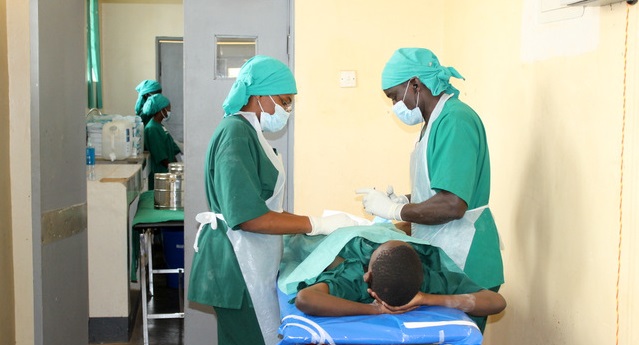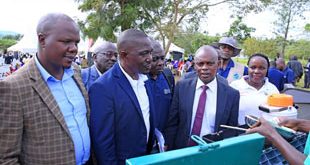
Kampala, Uganda | THE INDEPENDENT | An increasing number of men are opting for medical circumcision as Uganda works toward completely eradicating the AIDS disease by 2030, the Uganda Aids Commission (UAC) has disclosed.
Uganda adopted a comprehensive approach in the fight against HIV/AIDS, with medical circumcision being among the interventions to prevent the spread of the disease. While initially met with controversy in Ugandan society, it has gained acceptance over time.
Addressing journalists at a media center in preparation for the National HIV/AIDS Symposium, Daniel Byamukama, Head of HIV Prevention at the UAC, provided a comprehensive overview of the current state of the HIV/AIDS response and ongoing efforts to combat the epidemic.
Byamukama noted that, despite initial misconceptions about the strategy, the number of people seeking circumcision has increased, particularly among young adults. He stated, “Male circumcision is one of the strategies for HIV prevention in Uganda. The proportion of men aged 15 to 49 years who reported being circumcised increased from 42.2 percent in 2016 to 57.5 percent in 2020, with the highest prevalence among young people aged 15 to 24 years at 63%.”
Dr. Byamukama highlighted Uganda’s substantial progress over the past decade, with significant reductions in new HIV infections and related morbidity and mortality. “In 2022, the country recorded 52,000 new HIV infections and 17,000 AIDS-related deaths, a notable decrease from 2010 when there were 94,000 new infections and 56,000 deaths.”
Among other achievements in the fight against HIV/AIDS, preliminary results from the 2020 Population-based HIV Impact Assessment (UPHIA) indicate that Uganda is making significant progress toward achieving the UNAIDS 95-95-95 targets. This means a higher percentage of people living with HIV are aware of their status, on antiretroviral therapy (ART), and virally suppressed.
Data from the UAC shows that among adults aged 15 and above: 80.9% of those living with HIV were aware of their status, 96.1% of those aware of their HIV status were on ART, and 92.2% of those on ART were virally suppressed. Nevertheless, challenges remain, including identifying individuals who are unaware of their HIV status and ensuring treatment adherence among young people.
Mother-to-child transmission (MTCT) of HIV remains a concern, and efforts are needed to ensure that more children receive appropriate care and support. Byamukama noted, “Although Uganda has made significant progress in reducing MTCT in recent years, vertical infections remain high, estimated at approximately 5,300 in 2020. The reduction in vertical HIV infections is mainly attributed to the scale-up of effective PMTCT services under Option B+ that began in 2012.”
Dr. Byamukama also outlined other gaps in the fight against HIV/AIDS, including heavy reliance on external donors for funding, inequalities in HIV treatment, addressing risky sexual behavior, legal-policy and social challenges, and the importance of innovative, male-friendly testing and treatment programs.
He emphasized the importance of Uganda’s multisectoral approach to the HIV response, involving collaboration across various sectors, including Health, Education, Media, Culture, Faith, Hospitality, and Defense. This approach recognizes that the fight against HIV/AIDS requires a collective effort from all segments of society, and neglecting any aspect of this response could undermine the national commitment to ending AIDS as a public health threat by 2030.
UAC has organized the National HIV and AIDS Symposium 2023, scheduled for November 14-16, as part of its mandate. The event will take place at Kololo Independence Grounds and is open to the public. The theme for this year, “My Responsibility Towards Ending AIDS by 2030,” underscores the importance of individual contributions to the collective goal of ending the AIDS epidemic. The symposium will feature various events, including the National HIV and AIDS Scientific Meeting and a financing dialogue to discuss progress and challenges in realizing different financing mechanisms for the current National Strategic Plan (NSP).
****
URN
 The Independent Uganda: You get the Truth we Pay the Price
The Independent Uganda: You get the Truth we Pay the Price



Male circumcision is a dangerous distraction in the fight against HIV/AIDS.
From a USAID report:
“There appears no clear pattern of association between male circumcision and HIV prevalence—in 8 of 18 countries with data, HIV prevalence is lower among circumcised men, while in the remaining 10 countries it is higher.”
(this will include men who were circumcised tribally rather than medically, but they and their partners may also believe themselves to be protected, and the whole rationale for the RCTs into female-to-male transmission was a purported correlation between high rates of male circumcision and low rates of HIV)
From a study in South Africa in August 2018:
“Medically circumcised older men in a rural South African community had higher HIV prevalence than uncircumcised men, suggesting that the effect of selection into circumcision may be stronger than the biological efficacy of circumcision in preventing HIV acquisition.”
[or that male circumcision simply isn’t efficacious at preventing HIV acquisition]
It seems highly unrealistic to expect that there will be no risk compensation. The South African National Communication Survey on HIV/AIDS, 2009 found that 15% of adults across age groups “believe that circumcised men do not need to use condoms”. This figure seems to have been unchanged in 2012.
It is unclear if circumcised men are more likely to infect women. The only ever randomized controlled trial into male-to-female transmission showed a 54% higher rate in the group where the men had been circumcised:
ABC (Abstinence, Being faithful, and especially Condoms) is the way forward. Promoting genital surgery seems likely to cost African lives rather than save them.
Europeans don’t circumcise, South Americans don’t circumcise, Australians and New Zealanders used to circumcise but stopped, and less than half of North Americans circumcise. Why should Africans circumcise?
Recent news from Botswana:
“There is an upsurge of cases of people who got infected with HIV following circumcision.”
and from Zimbabwe:
“SOME circumcised men are contracting HIV and Aids after ditching the use of condoms, under a misguided belief that male circumcision (MC) would prevent them from getting infected”
and from Kenya:
“Push for male circumcision in Nyanza fails to reduce infections”
and from Uganda:
“A new study of 314 female s-x workers (FSWs) in Makindye division found that more than half of respondents falsely believe that once a man is circumcised, protection is not necessary during s-x.”
and from Malawi:
“According to the report, HIV rates have doubled in Malawi moving from 10% to 20% in 1 year. Strangely, this has been the same period that Malawians have been manipulatively forced to go through circumcision in masses with the promise that it reduces the contraction of HIV.”